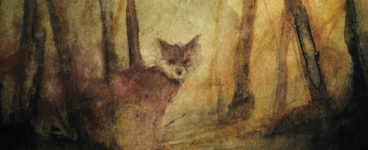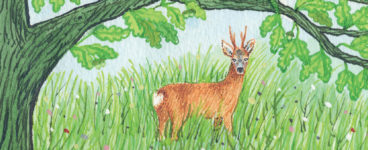Life in the Scottish Borders
‘Perhaps there is co-operation as well as competition in the natural world.’
The Secret History of Here is the story of a single place, a farm in the Scottish Borders. The site on which Alistair Moffat’s farm now stands has been occupied since pre-historic times. The fields have turned up ancient arrow heads, stone spindles, silver pennies and a stone carved with the rune-like letters of Ogham. Walking this landscape you can feel the presence and see the marks of those who lived here before.
But it is also the story of everywhere. In uncovering the history of one piece of land, Moffat shows how history is all around us, if only we have the eyes to see it. Under our feet, carved into the landscape, in the layout of paths and roads, in the stories we pass down, our history leaves its trace on the land.
Extract taken from The Secret History of Here
By Alistair Moffat
Published by Canongate
3 May
This morning I was much moved by a trivial, simple detail.
Amongst the birches on the margins of the Bottom Track, one with a rich, red bark took a terrible beating in last year’s summer storms. About halfway up its peeling trunk, a major limb had almost been torn off and come to rest not on the ground but on the branches of a sitka spruce that stands beside it. To my great surprise, the bough had kept enough of a connection with the trunk to come into leaf this spring and help the birch to photosynthesise and grow. I liked that – mutual support amongst the community of the trees.
4 May
It is very cold this morning, a bitter wind blowing out of the north-east that feels as though it has come straight off the wastes of Siberia. Even though the sun is brilliant in a cloudless, cerulean blue sky, the eye-blearing, ear-nipping cold means it does not feel like a May morning. The buds are closed tight against the overnight frost and, having been out all night in it, the horses in the Tile Field stand motionless, side on to the rising sun, soaking up its warmth across as much of their body area as possible. Maidie and I hurry on down the Long Track.
I read yesterday that by 2050 two-thirds of the world’s population will live in large cities. Even now there are hundreds in China and India that are so new I don’t recognise their names. These migrations mean that a mass consciousness of the natural rhythms of the planet will be much reduced and most people will cease to observe the cycle of growth through the seasons. There are satellite photos taken in darkness that show dense concentrations of light in Western Europe, the USA, India and China. That means many fewer people can see the stars and planets of the night sky. Far from being cosmopolitan, cities close down the world and the cosmos, shrink horizons and diminish our sense of how the world’s seasons change.
On our farm, I have learned that the weather and not the calendar turns time. At the beginning of May last year, a long, warm and dry period began with average temperatures double this morning’s values at over seventy degrees Fahrenheit (about twenty-one degrees Celsius). These conditions created a different landscape. A year ago I could smell the sweet scent of the stand of poplars at the gate into the Deer Park and the strawberries-and-cream blossom of the geans was everywhere. In the raised beds, my early potatoes had pushed up into the light (only to be earthed over) and the plum and apple trees were white with the flowers that would become fruit. The well-worn and much misunderstood phrase advising caution, ‘Ne’er cast a clout till May is out’, has nothing to do with the calendar. Winter clothes should only go back in the wardrobe when the blossom on the May Tree is out, a sign that the year has turned and the weather warmed.
5 May
Potatoes are much cheaper to buy than to grow when the cost of labour is taken into account, but last year’s earlies tasted sweet and earthy at the same time, a subtlety not available in the shops. And when they were cut prior to cooking, the juice shot out as though they were lemons. Even so, their clean, fresh taste is not why I grow the humble potato. I want to be involved in the cycle, have an annual harvest of some small sort and feel that our land could be productive. As the years roll on, I hope to plant more vegetables, rotate crops and build more raised beds. In the windless warmth of the old conservatory, the tomatoes are a riot of burgeoning greenery that will soon need support. Like me.
6 May
Illness prevented the planned survey of the area of the Doocot Field where Rory dug out the piece of lead that was suggestive of a structure of some sort. We hope to get out next weekend.
But meanwhile the mystery has deepened. Using baby oil to clean the piece of lead and show up any detail, Rory has discovered a surprising series of markings along the thickest edge. A row of vertical and precisely horizontal straight lines cut with a chisel, a burin or some other sharp tool, they are not accidental. But what do they mean?
At first Rory thought they might be a line of Ogham, the tree language I found on the inscribed stone in the Deer Park, but they don’t look right to me. Ogham is usually arranged on either side of an edge, an analogy for the trunk of a tree, and the stones sometimes have two flat planes. Or the inscriptions can be vertical, often cut into stones carved for other uses, such as standing stones, tombstones or crosses. Many that were carved on flat planes have a clear stemline that the letters cross or are attached to. These marks on the lead are not arranged in any of those patterns. I wonder if they are tally marks, a sequence of early arithmetic. In an age before paper, workmen made notes on all sorts of surfaces, including stone and lead. The marks look a little like five-bar gates, a common method of tallying I still sometimes use. Which leads to another question. What was being counted? Quantities in a building project? And if so, where was the building? It could have stood some distance from the find-spot. As it is now, lead was valuable and Rory might have retrieved a chunk of stolen property.
Enigmas like this are exhilarating and they prompt the past to come racing back across the centuries, make a grass field nibbled by ewes and their lambs come alive, reminding us that we are only one of many, the most recent generation to walk our lives under the big skies of the Borders. The dozens of silver pennies Rory has discovered remember the workings of a money economy based on precious metals, carried in pouches and lost on a forgotten journey up the Long Track. They are resonant echoes of transactions we can understand, and sometimes they are very surprising, like the imperial coin of Otto IV from Germany. But the piece of lead is different, perhaps impossible to understand. Is it evidence of a crime, the coldest of cold cases, or a tantalising fragment of an important building long lost in the grass? The wooden houses of our medieval ancestors were almost entirely built from organic, perishable materials. They did not use lead to keep their roofs watertight or their windows draught-proof. Somewhere important, a building of high status, is hiding from us and so is its story.
My morning walk with Maidie through a soft drizzle revealed an image of cheer, of hope. In a moss-covered old tree trunk by the edges of the Bottom Track that I had thought was a boulder, two birch saplings have seeded, their leaves bright lime-green and flushed with vigour. Inside that old stump lies a store of ancient goodness. And the sight of such unlikely fecundity sparked another thought. The underground web of thread-like connections between trees – old, young and even apparently dead – that is so memorably described in Peter Wohlleben’s magical book The Hidden Life of Trees may suggest an alternative to Darwinian evolution. Perhaps there is co-operation as well as competition in the natural world. The fittest trees survive with the help of their ancestors.
The Secret History of Here by Alistair Moffat is published by Canongate, priced £20.00.
ALSO IN THIS ISSUE

 This Is Our Undoing
This Is Our Undoing
‘The bear came forward, growling again, swung its head and lifted its wounded paw from the ground. H …

 The Nature of Summer, The Nature of Spring
The Nature of Summer, The Nature of Spring
‘It was a telling example of one of the bird’s character traits that distinguishes it from the golde …













